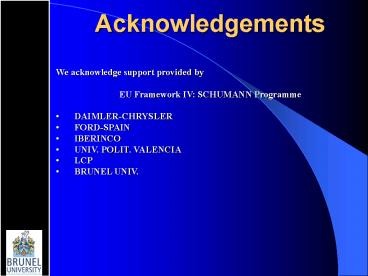We acknowledge support provided by PowerPoint PPT Presentation
1 / 38
Title: We acknowledge support provided by
1
Acknowledgements
- We acknowledge support provided by
- EU Framework IV SCHUMANN Programme
- DAIMLER-CHRYSLER
- FORD-SPAIN
- IBERINCO
- UNIV. POLIT. VALENCIA
- LCP
- BRUNEL UNIV.
2
Solving two-stage stochastic program using
lagrangean relaxation and sampling.
Chandra A. Poojari, Gautam Mitra
3
Outline
- Issues in decision making under uncertainty.
- Overview of the Capacity planning model.
- Approximated two-stage Integer Stochastic
program complete enumeration. - Apply Monte-Carlo Sampling to construct the
approximated problem. - Lagrangean on the Deterministic equivalent(DEQ).
- Importance Sampling and lagrangean on the DEQ.
- Computational results.
4
Decision making under uncertainty
Planning and utilisation of production
distribution capacities
.Optimal decisions Leading problem in
manufacturing and supply chain logistics Need
for regular evaluation of strategic asset
allocation decisions (rolling plan)uncertain
business environment
5
New Perspective of Investment Decisions
- The issues
- DCF is inadequate
- Three leading characteristics
- Investment Decisions (costs) irreversible
- Future returns are uncertain
- Another key aspect is timing
- Invest
- Disinvest
- Not investpostpone
- Are all strategic decisions
6
Uncertainty
- Future demand
- Future cost
- Future production
7
Decision making under uncertainty
Answer Buy flexibility ? Hedge against
uncertainty ? Make robust decisions
8
- Stochastic Programming with recourse models are
- ideally suited .. two perspectives
- (near) optimum resource allocation
- hedge against uncertain future outcomes
- Decisions not optimum for any one outcome, good
for many outcomes ! - Two stage models
- First Stage Here-and-Now asset allocation
decisions takes into consideration scenarios. - Second Stage Recourse decisions optimal
corrective actions as future unfolds
9
Supply Chain Model
10
The Model
The Declarative Model
- Logical Constraints
- Open/Close plant .. See below
- Line capacities at plants
- Special ordered set constraints
- Budget constraints
- 2. Operational Constraints
- Capacity constraints
- Demand constraints
The Procedural Model
- Column generation
11
Model Summary
Number of rows 6768 Number of integer variables
2096 Number of continuous variables
54400 Number of non-zeroes 1154034 Number of
scenarios 100
12
Model Data Instances
13
General two-stage SP
Subject to
let
Subject to
14
Model Data Instances
15
Lagrangean Decomposition
16
Lagrangean Decomposition
17
LR and Structural decomposition of Wait-and-See
problem
LR
fix
18
Lagrangean Relaxation
Stopping Criteria
1.
Pass ? Maximum Number of Iterations
2.
3.
Satisfaction of the relaxed constraints,
19
Enumerative approach Extended Scenario
Analysis(ESA)
For all
1.
, in ACS we fix the first-stage variable in
to
2.
We solve the resulting problem,
, for all scenarios.
We solve
Instances of
And choose the most robust solution,
20
Approximated model
APXP2SP
21
Monte-Carlo Sampling
- Randomly select scenarios.
- Generate integer solutions for these scenarios by
solving the corresponding Wait-and-See
problem. - Evaluate the performance of the solutions
generated against the 100 scenarios. - Re-sample the scenarios 4 times.
22
Deterministic equivalent
Model dimensions
23
Importance Sampling
with p.m.f
24
Approximating functions
where
- Additive function
2. Multiplicative function
25
Importance Sampling
where
if
then
26
Generation of integer solutions
S1
S2
S4
S3
27
ESA Parallelisation Strategy
S1,ACS
S2,ACS
S4,ACS
S3,ACS
28
Computational resultsApproximated problem
Performance of integer feasible solutions against
scenarios.
29
Computational results Approximated problem
Performance of integer feasible solution for the
approximated problem.
30
Computational results Approximated problem
Hedged values of the best solutions from
scenario analysis.
31
Approximated problem
32
Monte-Carlo Sampling
33
Lagrangean on the DEQ
34
Lagrangean on the DEQ Convergence to optimality
35
Importance Sampling on DEQ
Base Scenario having the highest cost
Base Scenario having the lowest cost
36
Importance Sampling on DEQ
Base Scenario having the highest cost
Base Scenario having the lowest cost
37
Issues in parallel implementation of importance
sampling and lagrangean
1. Functional and Data parallelisation. 2. Keep
track of the history of the lagrange multipliers
for all scenarios.
3.Speed-up in parallel environment
38
Thank you

